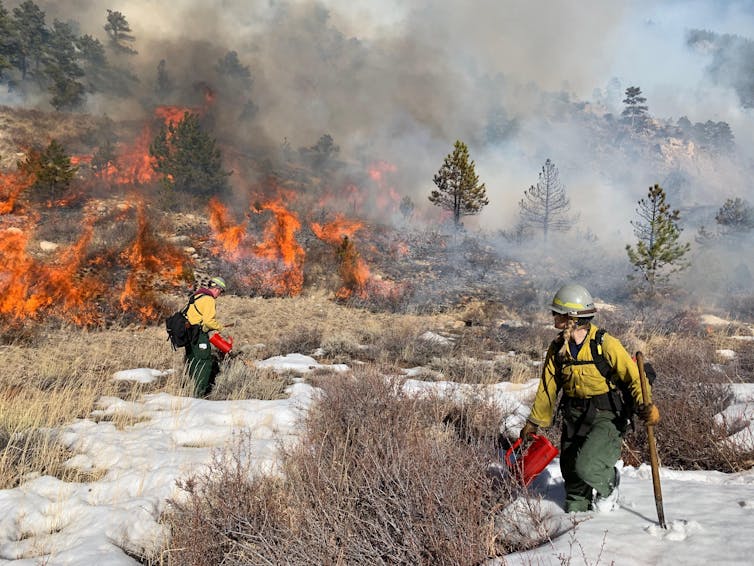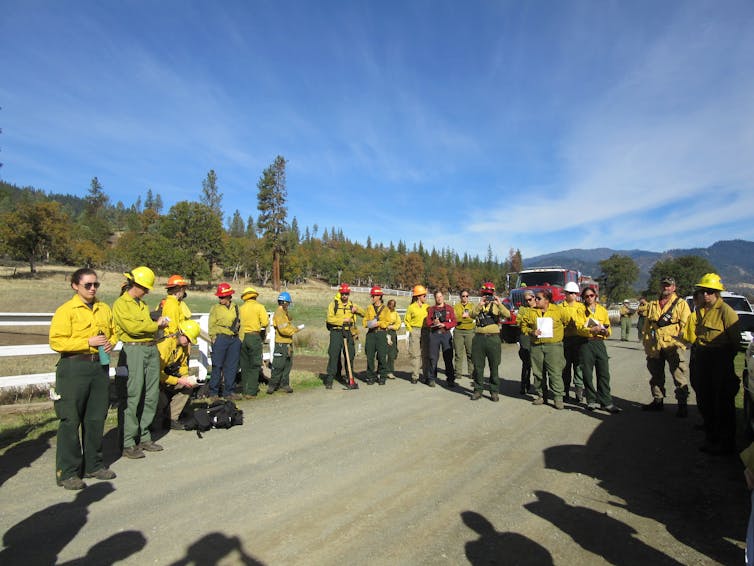Planned burns can reduce wildfire risks, but expanding use of 'good fire' isn't easy
- Written by Courtney Schultz, Associate Professor of Forest and Natural Resource Policy, Colorado State University
As spring settles in across the United States, western states are already preparing for summer and wildfire season. And although it may seem counter-intuitive, some of the most urgent conversations are about getting more fire onto the landscape.
Winter and spring, before conditions become too hot and dry, are common times for conducting planned and controlled burns designed to reduce wildfire hazard. Fire managers intentionally ignite fires within a predetermined area to burn brush, smaller trees and other plant matter.
Prescribed burns can decrease the potential for some of the large, severe fires that have affected western states[1] in recent years. As scholars of U.S. forest policy[2], collaborative environmental management[3] and social-ecological systems[4], we see them as a management tool that deserves much wider attention.
Fire managers conduct prescribed burns to improve forest conditions and reduce the threat of future wildfires.Forests need ‘good fire’
Forests across much of North America need fire to maintain healthy structures and watershed conditions and support biodiversity. For centuries, Native Americans deliberately set fires[5] to facilitate hunting, protect communities and foster plants needed for food and fiber.
But starting around the turn of the 20th century, European Americans began trying to suppress most fires and stopped prescribed burning. The exception was the Southeast, where forest managers and private landowners have consistently used prescribed burns to clear underbrush and improve wildlife habitat[6].
Suppressing wildfires[7] allows dead and living plant matter to accumulate. This harms forests by reducing nutrient recycling and overall plant diversity. It also creates more uniform landscapes with higher fuel loads[8], making forests prone to larger and more severe fires.
Today many forested landscapes in western states have a “fire debt[9].” Humans have prevented normal levels of fire from occurring, and the bill has come due. Increasingly severe weather conditions and longer fire seasons due to climate change[10] are making fire management problems more pressing today than they were just a few decades ago. And the problem will only get worse[11].
Fire science researchers have made a clear case for more burning, particularly in lower elevations and drier forests where fuels have built up. Studies show that reintroducing fire to the landscape, sometimes after thinning (removing some trees), often reduces fire risks more effectively than thinning alone[12]. It also can be the most cost-effective way to maintain desired conditions over time[13].
This winter in Colorado, for example, the Arapaho-Roosevelt National Forest conducted a prescribed burn[14] while snow still covered much of the ground. This was part of a broader strategy to increase prescribed fire use and create areas of burned ground that will make future wildland fires less extreme and more feasible to manage.
 A prescribed burn in the Arapahoe and Roosevelt National Forests, February 2019.
USFS[15]
A prescribed burn in the Arapahoe and Roosevelt National Forests, February 2019.
USFS[15]
State and local action heats up
From Oregon’s municipal watersheds to the Ponderosa pine forests of the Southwest, community-based partners and state and local agencies have been working with the federal government to remove accumulated fuel and reintroduce fire[16] on interconnected public and private forest lands.
California’s legislature has approved using money raised through the California carbon market[17] to fund prescribed fire efforts. New Mexico is using the Rio Grande Water Fund[18] – a public/private initiative that supports forest restoration to protect water supplies – to pay for thinning and prescribed burning[19], and is analyzing ways to expand use of prescribed fire[20] for forest management[21].
Oregon is in its first spring burning season with a newly revised smoke management plan[22] designed to provide more flexibility for prescribed burning. In Washington, the legislature passed a bill in 2016 creating a Forest Resiliency Burning Pilot Project[23], which just published a report[24] identifying ways to expand or continue use of prescribed fire.
At the community level, prescribed fire councils[25] are becoming common across the country, and a network[26] of fire-adapted communities[27] is growing. Nongovernmental organizations are building burn teams to address fire backlogs on public and private lands[28], and training people to conduct planned burns[29]. This work is all in an effort to build a bigger and more diverse prescribed fire workforce[30].
 Briefing before a prescribed fire training exercise for women in northern California.
USFS/Sarah McCaffrey
Briefing before a prescribed fire training exercise for women in northern California.
USFS/Sarah McCaffrey
Barriers to conducting prescribed fire
In our research on forest restoration efforts[31], we have found that some national policies are supporting larger-scale restoration planning and project work, such as tree thinning. But even where federal land managers and community partners are getting thinning accomplished and agree that burning is a priority, it has been hard to get more “good fire” on the ground[32].
To be sure, prescribed fire has limitations and risks. It will not stop wildfires under the most extreme conditions and is not appropriate in all locations. And on rare occasions[33], planned burns can escape controls, threatening lives and property[34]. But there is broad agreement that they are an important tool for supporting forest restoration and fuel mitigation[35].
The conventional wisdom is that air quality regulations, other environmental policies and public resistance[36] are the main barriers to prescribed fire. But when we interviewed some 60 experts, including land managers, air regulators, state agency partners and representatives from non-government organizations, we found that other factors were more significant obstacles[37].
As one land manager told us, “The law doesn’t necessarily impede prescribed burning so much as some of the more practical realities on the ground. You don’t have enough money, you don’t have enough people, or there’s too much fire danger” to pull off the burning.
In particular, fire managers said they needed adequate funding, strong government leadership and more people with expertise to conduct these operations. A major challenge is that qualified personnel are increasingly in demand for longer and more severe fire seasons, making them unavailable to help with planned burns when opportunities arise. Going forward, it will be particularly important to provide support for locations where partners and land managers have built agreement about the need for prescribed fire.
Humans have inextricably altered U.S. forests over the last century through fire exclusion, land use change, and now climate change. We cannot undo what has been done or suppress all fires - they are part of the landscape. The question now is where to invest in restoring forest conditions and promoting more resilient landscapes, while reducing risks to communities, ecosystems, wildlife, water and other precious resources. As part of a broader community of scientists and practitioners working on forest and fire management, we see prescribed fire as a valuable tool in that effort.
References
- ^ affected western states (theconversation.com)
- ^ U.S. forest policy (scholar.google.com)
- ^ collaborative environmental management (scholar.google.com)
- ^ social-ecological systems (scholar.google.com)
- ^ deliberately set fires (doi.org)
- ^ clear underbrush and improve wildlife habitat (www.srs.fs.usda.gov)
- ^ Suppressing wildfires (foresthistory.org)
- ^ more uniform landscapes with higher fuel loads (dx.doi.org)
- ^ fire debt (wildfiretoday.com)
- ^ due to climate change (theconversation.com)
- ^ will only get worse (www.outsideonline.com)
- ^ more effectively than thinning alone (dx.doi.org)
- ^ maintain desired conditions over time (doi.org)
- ^ conducted a prescribed burn (inciweb.nwcg.gov)
- ^ USFS (inciweb.nwcg.gov)
- ^ reintroduce fire (www.fs.fed.us)
- ^ California carbon market (resources.ca.gov)
- ^ Rio Grande Water Fund (riograndewaterfund.org)
- ^ thinning and prescribed burning (www.abqjournal.com)
- ^ expand use of prescribed fire (www.nmlegis.gov)
- ^ forest management (www.nature.org)
- ^ smoke management plan (www.oregon.gov)
- ^ Forest Resiliency Burning Pilot Project (www.putfiretowork.org)
- ^ report (www.dnr.wa.gov)
- ^ prescribed fire councils (www.prescribedfire.net)
- ^ network (fireadaptednetwork.org)
- ^ fire-adapted communities (www.fs.fed.us)
- ^ address fire backlogs on public and private lands (facnm.org)
- ^ training people to conduct planned burns (www.conservationgateway.org)
- ^ build a bigger and more diverse prescribed fire workforce (fireadaptednetwork.org)
- ^ forest restoration efforts (doi.org)
- ^ get more “good fire” on the ground (ewp.uoregon.edu)
- ^ rare occasions (doi.org)
- ^ threatening lives and property (www.denverpost.com)
- ^ supporting forest restoration and fuel mitigation (theconversation.com)
- ^ public resistance (www.fs.usda.gov)
- ^ more significant obstacles (ewp.uoregon.edu)
Authors: Courtney Schultz, Associate Professor of Forest and Natural Resource Policy, Colorado State University

